Hello!
I've enjoyed reading through this thread and appreciate all the info and photos. Cool stuff! I just wanted to throw my hat in with a few images from my collection:
1838 LM (NGC-AU58)
Thanks SimonW! Yes, the 33-L is probably in the neighborhood of a 53 (or maybe 55) . I'm going to send it to PCGS at some point. Since it was a tough one to find, I was just relieved it received a problem-free grade at the time
A couple new additions. I've got both off to PCGS for certification. First one is an upgrade for my 1827 NGC XF45, the other a tougher variety with the large "PESO 400 Gs." written. There are a few varieties for the year, I need to study them more.
Very cool! Just off the top of my head, I think there are at least four main varieties to 1859 (?) - need to look. I recently picked up a worn (and plugged) 1859 without the 'PESO' to go with the other ones that I have. I'll look tonight and try to narrow down the exact varieties in my collection. I think I might have an example of each now. Curious to see what yours grade as. Good luck!
@SolMan said:
Very cool! Just off the top of my head, I think there are at least four main varieties to 1859 (?) - need to look. I recently picked up a worn (and plugged) 1859 without the 'PESO' to go with the other ones that I have. I'll look tonight and try to narrow down the exact varieties in my collection. I think I might have an example of each now. Curious to see what yours grade as. Good luck!
Welcome! I'd be interested in seeing your varieties!
@SolMan said:
Very cool! Just off the top of my head, I think there are at least four main varieties to 1859 (?) - need to look. I recently picked up a worn (and plugged) 1859 without the 'PESO' to go with the other ones that I have. I'll look tonight and try to narrow down the exact varieties in my collection. I think I might have an example of each now. Curious to see what yours grade as. Good luck!
I was thinking it might grade as a midrange VF, but I'm not sure, I've never really dealt with anything lower than XF with 8 sol coins.
Hi Simon - here are some photos of the 1859 8 Soles that I currently have. Looks like they're all KM#138.3 with the exception of the beat up one (C) I got recently without the 'PESO' (KM#138.4). It's pretty wild how much variation there is between the dies on these - I'll have to see if any match yours above.
@SolMan it doesn’t appear to match any of yours, they seem to all be from different dies, on the obverse anyway. I really don’t think the dies lasted very long with Bolivian republic coinage. It’s more like EVERY coin was punched individually rather than from a set of dies. It’s crazy. All I can assume is that the steel was low quality and the dies just didn’t last very long. Makes for some pretty interesting study.
That's an interesting hypothesis about the dies - if they didn't last long, that would certainly explain all the variations. I've been collecting the 8 Soles for a while but I haven't started to really dive into any of the other denominations yet. (Though I'm keeping my eyes peeled for pre-1830 dates). I think the 2 Soles series might be the toughest, based on what I've seen come up for sale. As for the 8 Soles, 1859 is the year I have the most of. It's hard to narrow it down to a couple because each one is so distinct.
On another note, I did finally add a 1848-M to the collection! I saw a raw one in VF come up for sale in an auction earlier this year. Looks like it may have been lightly polished at one point, but I'll take it!
@SolMan said:
That's an interesting hypothesis about the dies - if they didn't last long, that would certainly explain all the variations. I've been collecting the 8 Soles for a while but I haven't started to really dive into any of the other denominations yet. (Though I'm keeping my eyes peeled for pre-1830 dates). I think the 2 Soles series might be the toughest, based on what I've seen come up for sale. As for the 8 Soles, 1859 is the year I have the most of. It's hard to narrow it down to a couple because each one is so distinct.
On another note, I did finally add a 1848-M to the collection! I saw a raw one in VF come up for sale in an auction earlier this year. Looks like it may have been lightly polished at one point, but I'll take it!
I would agree with you, 2 sol is the toughest denomination. A bunch of the 4 Sol coins are pretty tough. The 8’s are probably the easiest, but also have the highest demand, which might actually make the 1/2 set easier to collect, since there’s little demand.
Rarity-wise I’d say it probably goes, from toughest to easiest 2, 4, 1, 1/2, 8. (In decent grades especially.)
But adding in demand and competition the 8 soles probably move up a few slots, much more people looking for nice quality stuff versus the other denominations.
You gotta be pretty into the Sol coins to dive into the 2 denomination I would think.
@SimonW said:
I really don’t think the dies lasted very long with Bolivian republic coinage. It’s more like EVERY coin was punched individually rather than from a set of dies. It’s crazy. All I can assume is that the steel was low quality and the dies just didn’t last very long. Makes for some pretty interesting study.
According to the book by Prado Robles, G. (2001) "Effects of the economic development of the coin in Bolivia, 1830-1870" in 1859, 68,701 coins were minted.
As I understand it, this number includes 8 soles coins of all varieties, including those weighing 27.07 grams. The number of each variety of the 8 soles coin of 1859 hardly exceeded 20-25,000.
It is strange that such a small number were minted with different dies. The previous type of 8 soles coins were minted with dies that were made using a master punch. This allowed for uniformity of dies.
Interesting! Also, why was 1859 the only year that PESO was used on the coin? Did this have something to do with trade? I'd love to get my hands on a copy of that book if it's still in print - and in English
We appear to have six distinct obverse dies shown here. There are certainly more out there. With a mintage of 68,701, that makes it just over 10k coins each per die based on just the coins we have here.
From what I’m reading a lower quality, medieval die might last:
“In the late Middle Ages, a "hammer" die could last for about 17,000 strikes, while an "anvil" die could last for about 36,000 strikes. “
Which seems to suggest that these dies lasted less time than medieval dies. I wonder why…
@SolMan said:
Interesting! Also, why was 1859 the only year that PESO was used on the coin? Did this have something to do with trade? I'd love to get my hands on a copy of that book if it's still in print - and in English
In this case, the word PESO is not the name of a monetary unit (like the word dollar), but the word WEIGHT (WEIGHT OF 400 GRAINS). This word was also minted on other coins of small denominations (the coins shown are not mine).
I already wrote above that these coins were intended primarily for the exchange of 4-sol coins with a fineness of 0.666 among the population. In international trade, these coins were accepted at a rate of not 8 soles, but only 6 soles.
Much more interesting (and rare) is the book by Julio Benavides (1972), Historia de la Moneda en Bolivia. All information on the mintages of the coins that I showed above is taken from this book.
We appear to have six distinct obverse dies shown here. There are certainly more out there. With a mintage of 68,701, that makes it just over 10k coins each per die based on just the coins we have here.
From what I’m reading a lower quality, medieval die might last:
“In the late Middle Ages, a "hammer" die could last for about 17,000 strikes, while an "anvil" die could last for about 36,000 strikes. “
Which seems to suggest that these dies lasted less time than medieval dies. I wonder why…
I think there are a number of problems here.
Of course, the dies were made of bad metal. This problem remained when they started minting boliviano coins later.
But perhaps the main reason for the frequent change of dies in 1859 was that the government and the mint were looking for the best design for this type of coin. And therefore, they did not make a working master punch that could ensure the uniformity of the coins.
The 8 sole coins with the inscription 400 grains, which were minted in 1860-63, are much more uniform. The design was approved and confirmed.
We appear to have six distinct obverse dies shown here. There are certainly more out there. With a mintage of 68,701, that makes it just over 10k coins each per die based on just the coins we have here.
From what I’m reading a lower quality, medieval die might last:
“In the late Middle Ages, a "hammer" die could last for about 17,000 strikes, while an "anvil" die could last for about 36,000 strikes. “
Which seems to suggest that these dies lasted less time than medieval dies. I wonder why…
I think there are a number of problems here.
Of course, the dies were made of bad metal. This problem remained when they started minting boliviano coins later.
But perhaps the main reason for the frequent change of dies in 1859 was that the government and the mint were looking for the best design for this type of coin. And therefore, they did not make a working master punch that could ensure the uniformity of the coins.
The 8 sole coins with the inscription 400 grains, which were minted in 1860-63, are much more uniform. The design was approved and confirmed.
That makes sense, for sure. A lot of extra work making a new working die each time you broke one…a lot more work.
Here's a link to a digital version of the book. It's in spanish, so if you don't hablar you may need to use google translate for the sections that you need translated.
I have dowloaded the book, if anyone has questions in the future about this stuff.
@SimonW said:
Here's a link to a digital version of the book. It's in spanish, so if you don't hablar you may need to use google translate for the sections that you need translated.
I have dowloaded the book, if anyone has questions in the future about this stuff.
Thanks! Will check it out. I'll use a combination of my three years of High School Spanish from 35 years ago, Google Translate, and my GF who is originally from Mex City
@SimonW said:
Here's a link to a digital version of the book. It's in spanish, so if you don't hablar you may need to use google translate for the sections that you need translated.
I have dowloaded the book, if anyone has questions in the future about this stuff.
@SimonW said:
Here's a link to a digital version of the book. It's in spanish, so if you don't hablar you may need to use google translate for the sections that you need translated.
I have dowloaded the book, if anyone has questions in the future about this stuff.
@SolMan said:
That's a nice one! All the detail in Bolivar's jacket and stylish sideburns is there
Totally! Here's as another great strike, but worn on the sideburns. Note the collar. Almost never do the details show up on the collar, at any level of preservation. That flowery design is very very rare in my experience.
This is a great thread with lots of terrific coins and pictures. Regarding one of the 1827 8 soles, the one with the scratch in front of Bolivar's face, that coin was sold in the Ponterio NY sale, January 2009. I have attached a picture of the auction catalog that describes that coin.
@JBrown_BolRep said:
This is a great thread with lots of terrific coins and pictures. Regarding one of the 1827 8 soles, the one with the scratch in front of Bolivar's face, that coin was sold in the Ponterio NY sale, January 2009. I have attached a picture of the auction catalog that describes that coin.
Here is a very rare proof 8 soles, one of two proofs that I’ve seen personally. The other one was an 1853 FP in Brass NGC PF64, in the same Pontario sale as the 1827 coin, amazing rarities!
That’s incredible! I have wondered how many exist. Do you think there are minors like this also? Normally I expect off metal coins to be counterfeits, but I always hope it’s a minor version of these proofs.
@JBrown_BolRep said:
Here is a very rare proof 8 soles, one of two proofs that I’ve seen personally. The other one was an 1853 FP in Brass NGC PF64, in the same Pontario sale as the 1827 coin, amazing rarities!
If I am not mistaken, this coin was first called a PATTERN in the 1929 catalogue of the Julius Guttag collection.
Although it seems to me that this is not a pattern, but one of the minted in Europe restrikes (?) for collectors.
Great information, do you have a draft copy of the Guttag book (is that what the second photo represents)? Both pictures are my coin as you can see the mark below the "A" and in front of forehead and the small dot behind the head band ends above the "O" matches with my coin. Its cool to know this is the plate coin from the Guttag collection as the seller didn't have that information. The theory of a restrike vs. pattern makes sense, especially if it was made in Europe (i.e England or France based off the quality of strike). Thanks...JB
And here are three KM 138.3 reverses, notice the dot between F & J, one is mid height, one is low and the last is no dot. I have several other 1859 coins so after reading this thread I plan to do a little study of the die differences.
@JBrown_BolRep said:
do you have a draft copy of the Guttag book (is that what the second photo represents)? The theory of a restrike vs. pattern makes sense, especially if it was made in Europe (i.e England or France based off the quality of strike)
Five volumes of the draft catalogue of Julius Guttag are freely available on the Internet Archive website. I think in this form the catalogue of the collection is better than the scans of the printed edition.
In general, this is a very interesting topic for research. There are several samples of coins of Peru, Bolivia, the Central American Republic, which are clearly made in Europe or the USA and are considered patterns.
@JBrown_BolRep said:
Here is the 1859 without weight below bust, which I believe is the scarcest of the 1859 issues (although my interest is with the earlier designs).
This coin has a standard weight of 27.07 grams for the 8 soles denomination.
The slab is mistakenly written that the weight is indicated above the llamas.
The silver standard 10 dineros 20 grains is indicated above the llamas
That’s incredible! I have wondered how many exist. Do you think there are minors like this also? Normally I expect off metal coins to be counterfeits, but I always hope it’s a minor version of these proofs.
I have not seen a minor proof coin in any of the major sales or shows. I actively look through old sales to explore new possible coins that aren’t listed in Krause. I have a fair amount of counterfeits, typically 4 soles, made from lots of different materials but their strikes/designs are typically cartoonish. The fact that both the 8S examples I’ve seen are 1853 FP, it makes me think that the “restrike” theory could be correct or that pattern/samples were struck to go along with the dies. To me the 1852-1856 portrait years have really sharp details (could they have been struck for Bolivia at a more advanced mint). Reminds me of the 1858 5F Ecuador coin which was produced in France.
These types of questions/discussions is what pulled me into Bolivia and other S. American Republic series coins. So many varieties compared to collecting US Roosevelt dimes for example. My focus now is unholed Bolivian proclamations.
The fact that both the 8S examples I’ve seen are 1853 FP, it makes me think that the “restrike” theory could be correct or that pattern/samples were struck to go along with the dies. To me the 1852-1856 portrait years have really sharp details (could they have been struck for Bolivia at a more advanced mint). Reminds me of the 1858 5F Ecuador coin which was produced in France.
The 1858 Ecuadorian 5 francs were struck at the Quito mint, not Paris.
The main reason I believe the coins shown are restrikes and not patterns is that they were struck "in collar" on a steam-powered press. The mints of the Latin American republics at the time used old, hand-operated presses. The real patterns (with signs of "in collar" striking) appeared when the old presses were planned to be replaced by steam presses. For example, the 1868 Clemente Torretti 1 boliviano pattern was made as a sample of the minting of the steam press that Torretti was selling to the Bolivian government. In 1853, as far as I know, the Bolivian government did not plan to replace the old hand presses with new steam presses.
Comments
@Vasanti Seriously funny 😂
I'm BACK!!! Used to be Billet7 on the old forum.
Hello!

I've enjoyed reading through this thread and appreciate all the info and photos. Cool stuff! I just wanted to throw my hat in with a few images from my collection:
1838 LM (NGC-AU58)
1863 FP (NGC-MS63)

1856 FJ (ICG-EF45)

1833 L (ANACS AU50)

Welcome @AlpacaSulcata !!! Glad you have you. Some very nice pieces you have there. That last one looks a bit better than a 50 to me.
I'm BACK!!! Used to be Billet7 on the old forum.
Thanks SimonW! Yes, the 33-L is probably in the neighborhood of a 53 (or maybe 55) . I'm going to send it to PCGS at some point. Since it was a tough one to find, I was just relieved it received a problem-free grade at the time
A couple new additions. I've got both off to PCGS for certification. First one is an upgrade for my 1827 NGC XF45, the other a tougher variety with the large "PESO 400 Gs." written. There are a few varieties for the year, I need to study them more.
I'm BACK!!! Used to be Billet7 on the old forum.
Very cool! Just off the top of my head, I think there are at least four main varieties to 1859 (?) - need to look. I recently picked up a worn (and plugged) 1859 without the 'PESO' to go with the other ones that I have. I'll look tonight and try to narrow down the exact varieties in my collection. I think I might have an example of each now. Curious to see what yours grade as. Good luck!
Welcome! I'd be interested in seeing your varieties!
I'm BACK!!! Used to be Billet7 on the old forum.
I was thinking it might grade as a midrange VF, but I'm not sure, I've never really dealt with anything lower than XF with 8 sol coins.
I'm BACK!!! Used to be Billet7 on the old forum.
Thanks Simon! I will post some photos of the 1859 varieties that I have in the next few days.
Hi Simon - here are some photos of the 1859 8 Soles that I currently have. Looks like they're all KM#138.3 with the exception of the beat up one (C) I got recently without the 'PESO' (KM#138.4). It's pretty wild how much variation there is between the dies on these - I'll have to see if any match yours above.





@SolMan
Dang! I’ve never seen that many for sale, you must have been collecting for quite some time. Lots of variation for sure!
I'm BACK!!! Used to be Billet7 on the old forum.
@SolMan it doesn’t appear to match any of yours, they seem to all be from different dies, on the obverse anyway. I really don’t think the dies lasted very long with Bolivian republic coinage. It’s more like EVERY coin was punched individually rather than from a set of dies. It’s crazy. All I can assume is that the steel was low quality and the dies just didn’t last very long. Makes for some pretty interesting study.
I'm BACK!!! Used to be Billet7 on the old forum.
That's an interesting hypothesis about the dies - if they didn't last long, that would certainly explain all the variations. I've been collecting the 8 Soles for a while but I haven't started to really dive into any of the other denominations yet. (Though I'm keeping my eyes peeled for pre-1830 dates). I think the 2 Soles series might be the toughest, based on what I've seen come up for sale. As for the 8 Soles, 1859 is the year I have the most of. It's hard to narrow it down to a couple because each one is so distinct.
On another note, I did finally add a 1848-M to the collection! I saw a raw one in VF come up for sale in an auction earlier this year. Looks like it may have been lightly polished at one point, but I'll take it!
I would agree with you, 2 sol is the toughest denomination. A bunch of the 4 Sol coins are pretty tough. The 8’s are probably the easiest, but also have the highest demand, which might actually make the 1/2 set easier to collect, since there’s little demand.
Rarity-wise I’d say it probably goes, from toughest to easiest 2, 4, 1, 1/2, 8. (In decent grades especially.)
But adding in demand and competition the 8 soles probably move up a few slots, much more people looking for nice quality stuff versus the other denominations.
You gotta be pretty into the Sol coins to dive into the 2 denomination I would think.
I'm BACK!!! Used to be Billet7 on the old forum.
According to the book by Prado Robles, G. (2001) "Effects of the economic development of the coin in Bolivia, 1830-1870" in 1859, 68,701 coins were minted.


As I understand it, this number includes 8 soles coins of all varieties, including those weighing 27.07 grams. The number of each variety of the 8 soles coin of 1859 hardly exceeded 20-25,000.
It is strange that such a small number were minted with different dies. The previous type of 8 soles coins were minted with dies that were made using a master punch. This allowed for uniformity of dies.
Fac quod debes, fiat quod fiet
Interesting! Also, why was 1859 the only year that PESO was used on the coin? Did this have something to do with trade? I'd love to get my hands on a copy of that book if it's still in print - and in English
@genosse
That’s great research!
We appear to have six distinct obverse dies shown here. There are certainly more out there. With a mintage of 68,701, that makes it just over 10k coins each per die based on just the coins we have here.
From what I’m reading a lower quality, medieval die might last:
“In the late Middle Ages, a "hammer" die could last for about 17,000 strikes, while an "anvil" die could last for about 36,000 strikes. “
Which seems to suggest that these dies lasted less time than medieval dies. I wonder why…
I'm BACK!!! Used to be Billet7 on the old forum.
@SolMan
https://books.openedition.org/ifea/7430
I'm BACK!!! Used to be Billet7 on the old forum.
In this case, the word PESO is not the name of a monetary unit (like the word dollar), but the word WEIGHT (WEIGHT OF 400 GRAINS). This word was also minted on other coins of small denominations (the coins shown are not mine).


I already wrote above that these coins were intended primarily for the exchange of 4-sol coins with a fineness of 0.666 among the population. In international trade, these coins were accepted at a rate of not 8 soles, but only 6 soles.
Much more interesting (and rare) is the book by Julio Benavides (1972), Historia de la Moneda en Bolivia. All information on the mintages of the coins that I showed above is taken from this book.
Fac quod debes, fiat quod fiet
I think there are a number of problems here.
Of course, the dies were made of bad metal. This problem remained when they started minting boliviano coins later.
But perhaps the main reason for the frequent change of dies in 1859 was that the government and the mint were looking for the best design for this type of coin. And therefore, they did not make a working master punch that could ensure the uniformity of the coins.
The 8 sole coins with the inscription 400 grains, which were minted in 1860-63, are much more uniform. The design was approved and confirmed.
Fac quod debes, fiat quod fiet
Good thread, thanks guys!
Latin American Collection
That makes sense, for sure. A lot of extra work making a new working die each time you broke one…a lot more work.
I'm BACK!!! Used to be Billet7 on the old forum.
Someone could spend a long time on a concise study of JUST the 1859 coins.
I'm BACK!!! Used to be Billet7 on the old forum.
Here's a link to a digital version of the book. It's in spanish, so if you don't hablar you may need to use google translate for the sections that you need translated.
I have dowloaded the book, if anyone has questions in the future about this stuff.
https://www.scribd.com/document/700810170/Historia-de-la-moneda-en-Bolivia-Benavides#download
I'm BACK!!! Used to be Billet7 on the old forum.
Thanks! Will check it out. I'll use a combination of my three years of High School Spanish from 35 years ago, Google Translate, and my GF who is originally from Mex City
It's strange, this site doesn't give me a link to the book

Fac quod debes, fiat quod fiet
Looks like you might have to sign up to get it. There’s a download for sure on the site. I ended up printing all 270ish pages into a book.
I'm BACK!!! Used to be Billet7 on the old forum.
Great strike on this one!
I'm BACK!!! Used to be Billet7 on the old forum.
That's a nice one! All the detail in Bolivar's jacket and stylish sideburns is there
Totally! Here's as another great strike, but worn on the sideburns. Note the collar. Almost never do the details show up on the collar, at any level of preservation. That flowery design is very very rare in my experience.
I'm BACK!!! Used to be Billet7 on the old forum.
This is a great thread with lots of terrific coins and pictures. Regarding one of the 1827 8 soles, the one with the scratch in front of Bolivar's face, that coin was sold in the Ponterio NY sale, January 2009. I have attached a picture of the auction catalog that describes that coin.
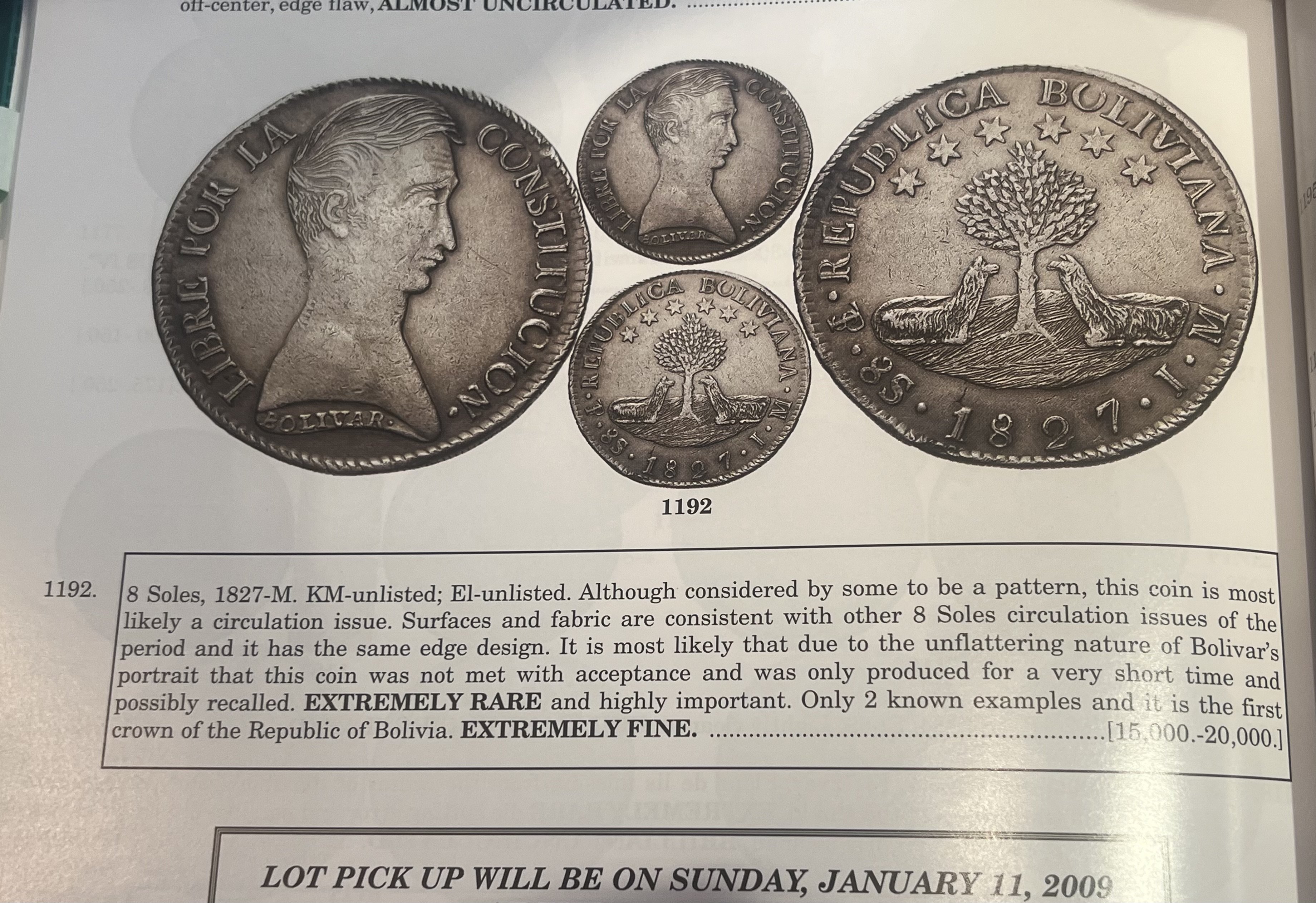
The same J. Brown from the NGC registry???
I'm BACK!!! Used to be Billet7 on the old forum.
Yes, nice to meet you and see all the great information being shared here.
That’s compliment coming from a BIG collector of the series, welcome! Glad to have you.
I'm BACK!!! Used to be Billet7 on the old forum.
Here is a very rare proof 8 soles, one of two proofs that I’ve seen personally. The other one was an 1853 FP in Brass NGC PF64, in the same Pontario sale as the 1827 coin, amazing rarities!
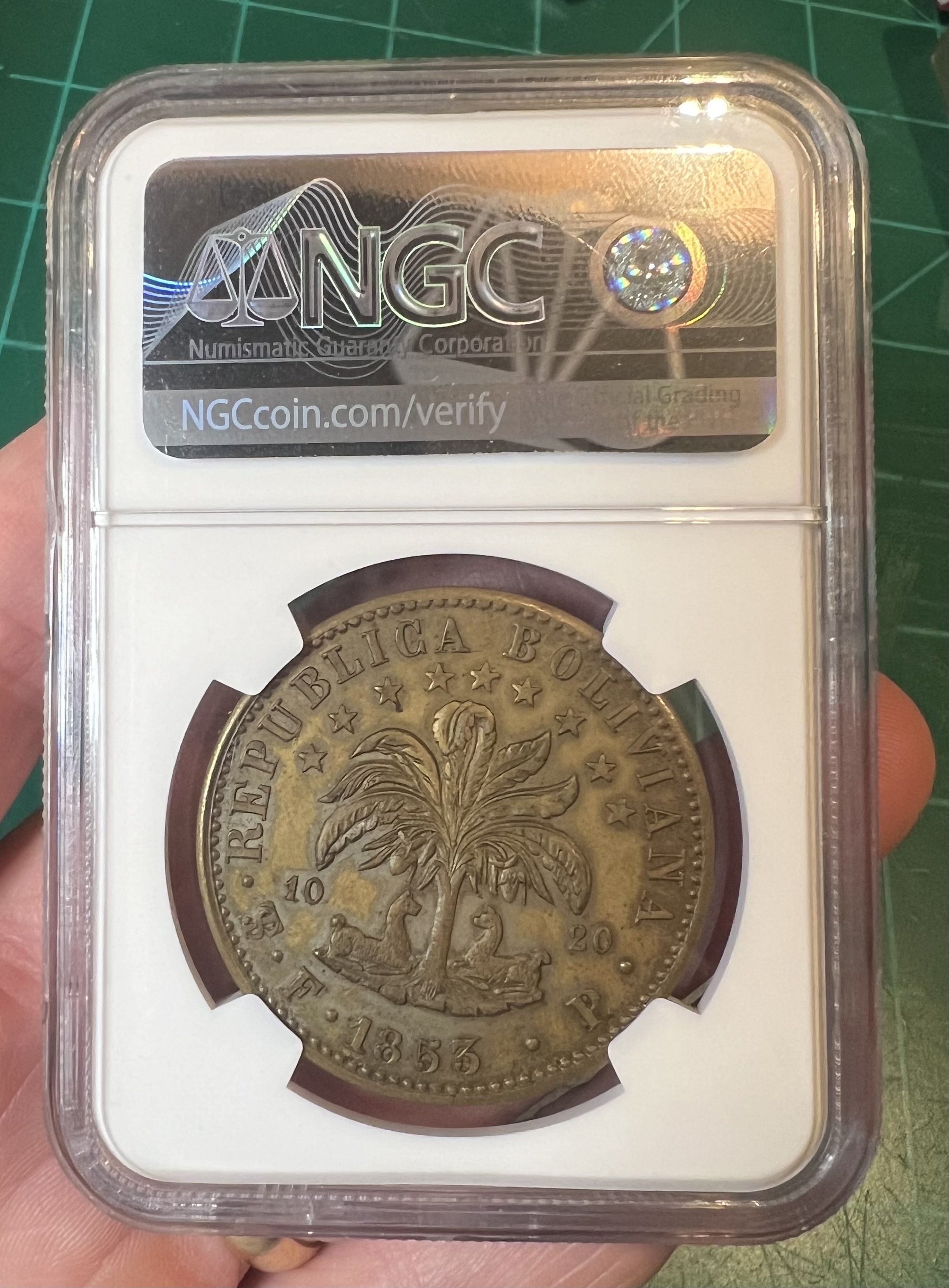
@JBrown_BolRep
That’s incredible! I have wondered how many exist. Do you think there are minors like this also? Normally I expect off metal coins to be counterfeits, but I always hope it’s a minor version of these proofs.
I'm BACK!!! Used to be Billet7 on the old forum.
If I am not mistaken, this coin was first called a PATTERN in the 1929 catalogue of the Julius Guttag collection.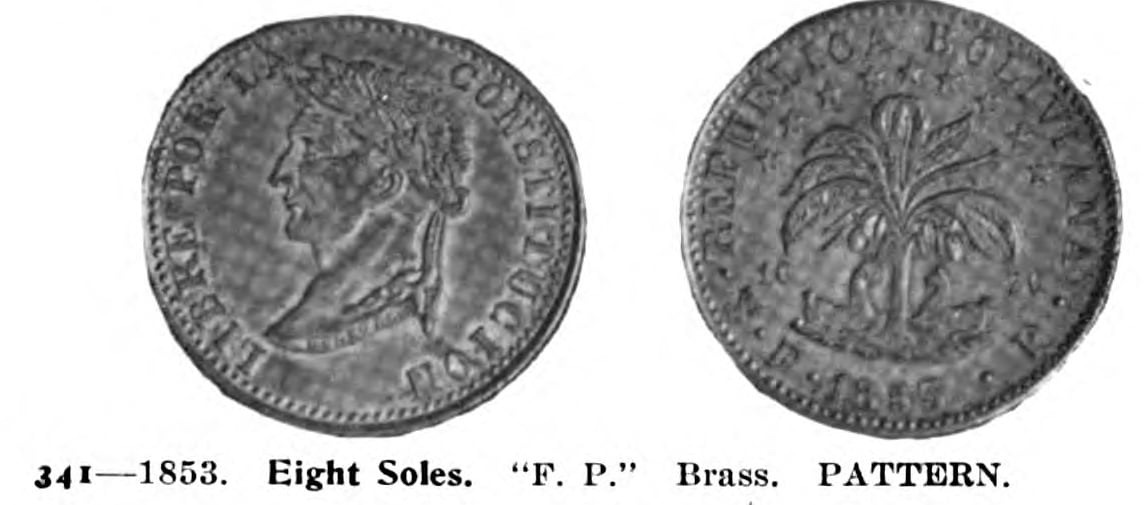
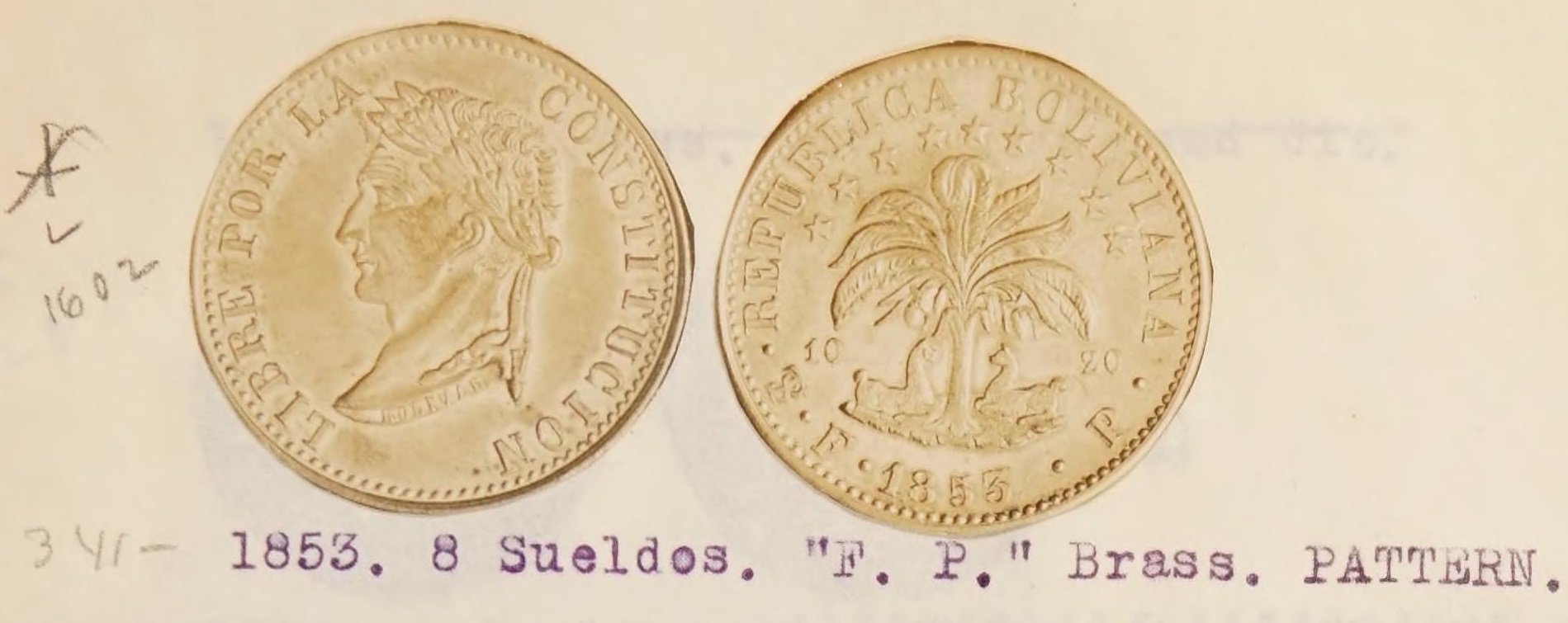
Although it seems to me that this is not a pattern, but one of the minted in Europe restrikes (?) for collectors.
Fac quod debes, fiat quod fiet
Great information, do you have a draft copy of the Guttag book (is that what the second photo represents)? Both pictures are my coin as you can see the mark below the "A" and in front of forehead and the small dot behind the head band ends above the "O" matches with my coin. Its cool to know this is the plate coin from the Guttag collection as the seller didn't have that information. The theory of a restrike vs. pattern makes sense, especially if it was made in Europe (i.e England or France based off the quality of strike). Thanks...JB
Here is the 1859 without weight below bust, which I believe is the scarcest of the 1859 issues (although my interest is with the earlier designs).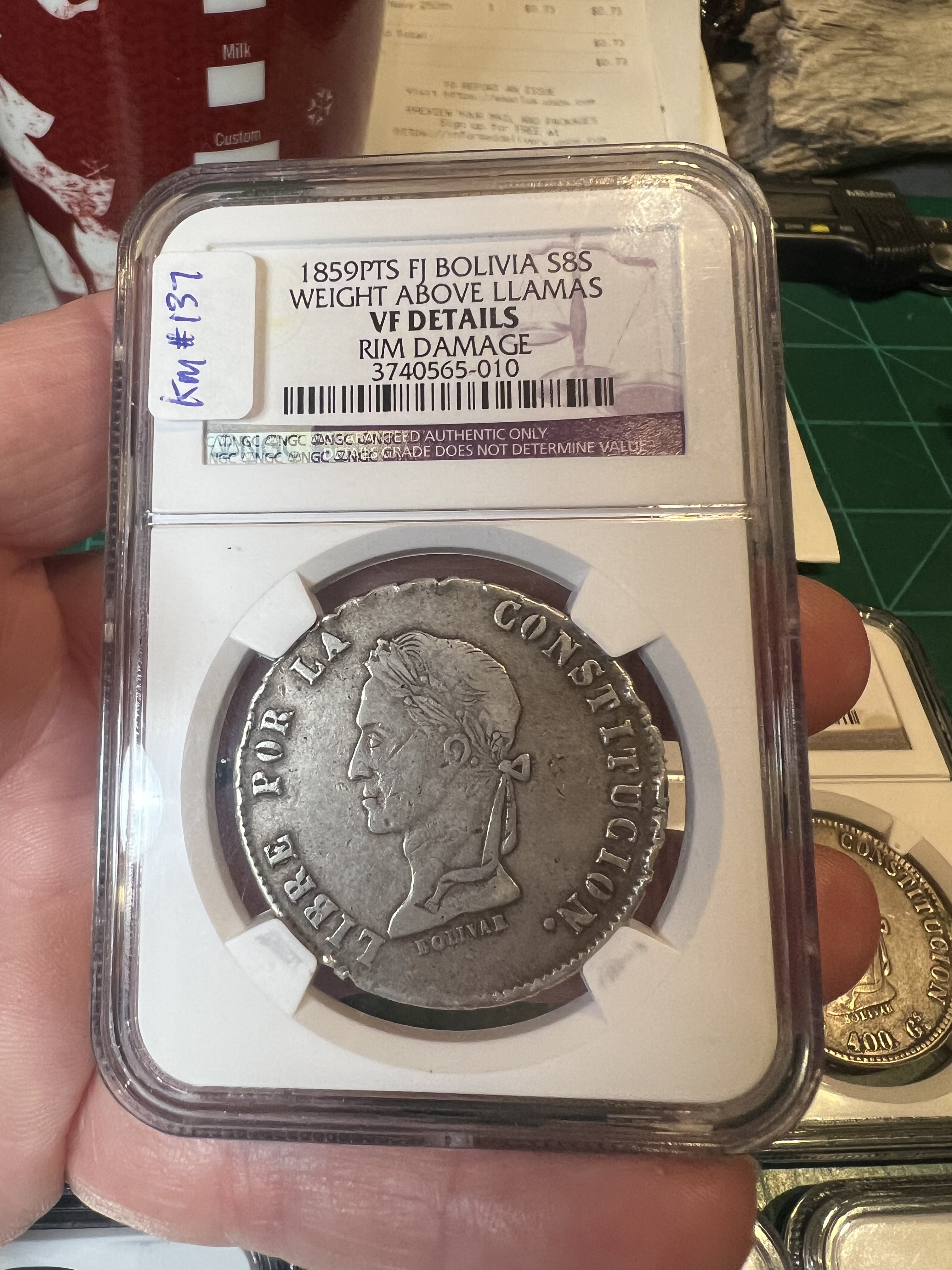
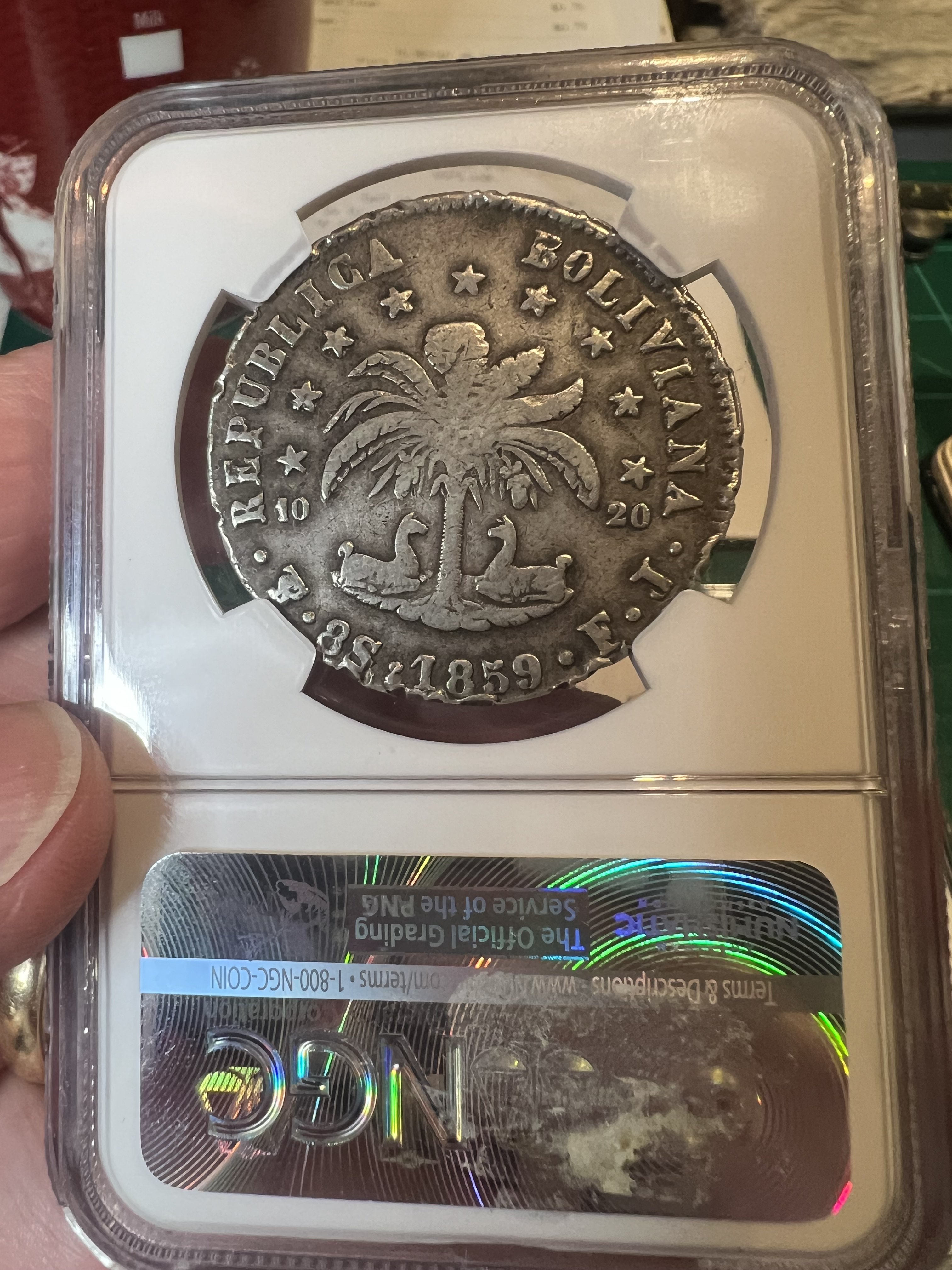
And here are three KM 138.3 reverses, notice the dot between F & J, one is mid height, one is low and the last is no dot. I have several other 1859 coins so after reading this thread I plan to do a little study of the die differences.
A fun 8 soles turned into a lighter, amazing how well machined the parts are.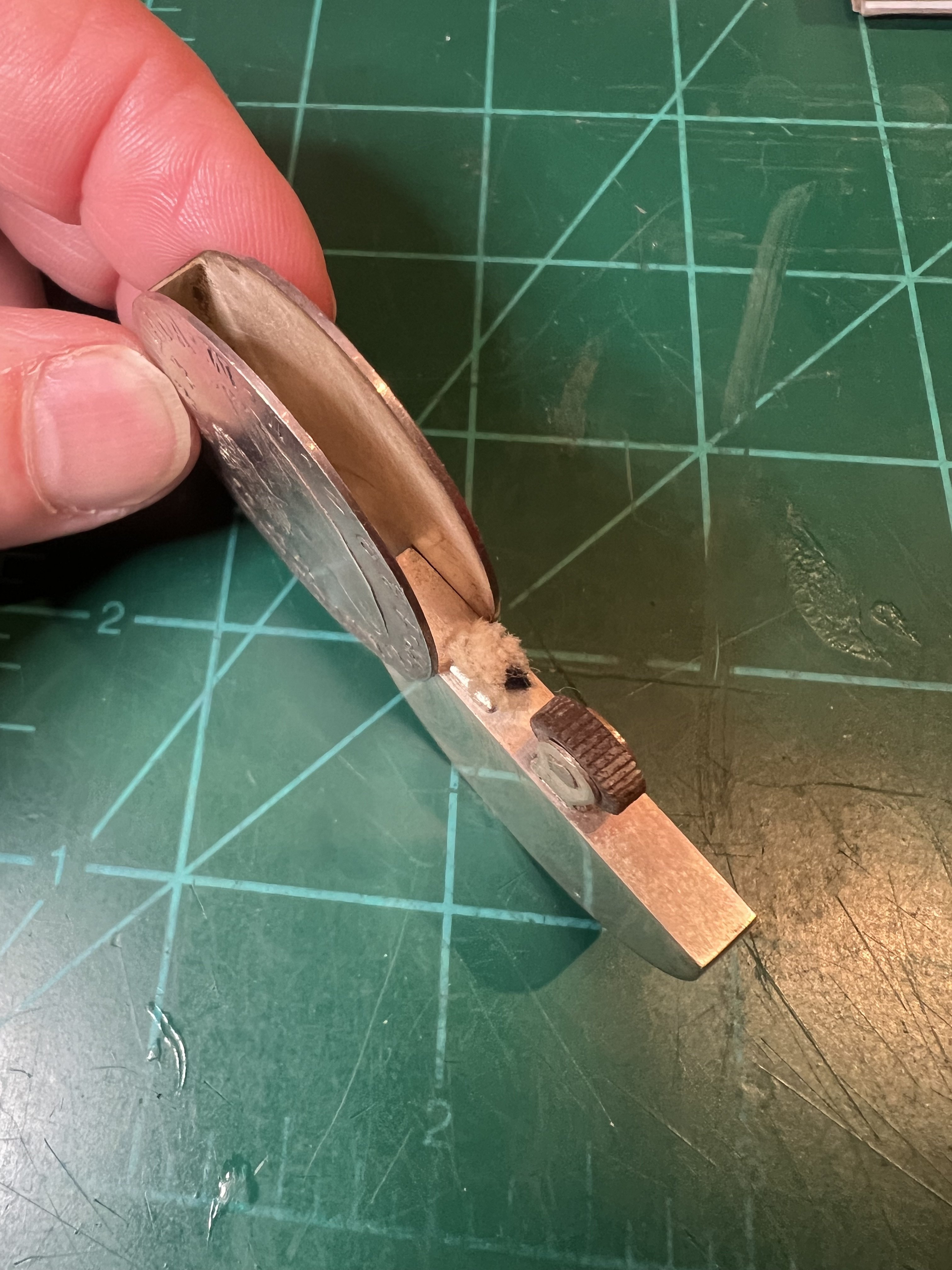
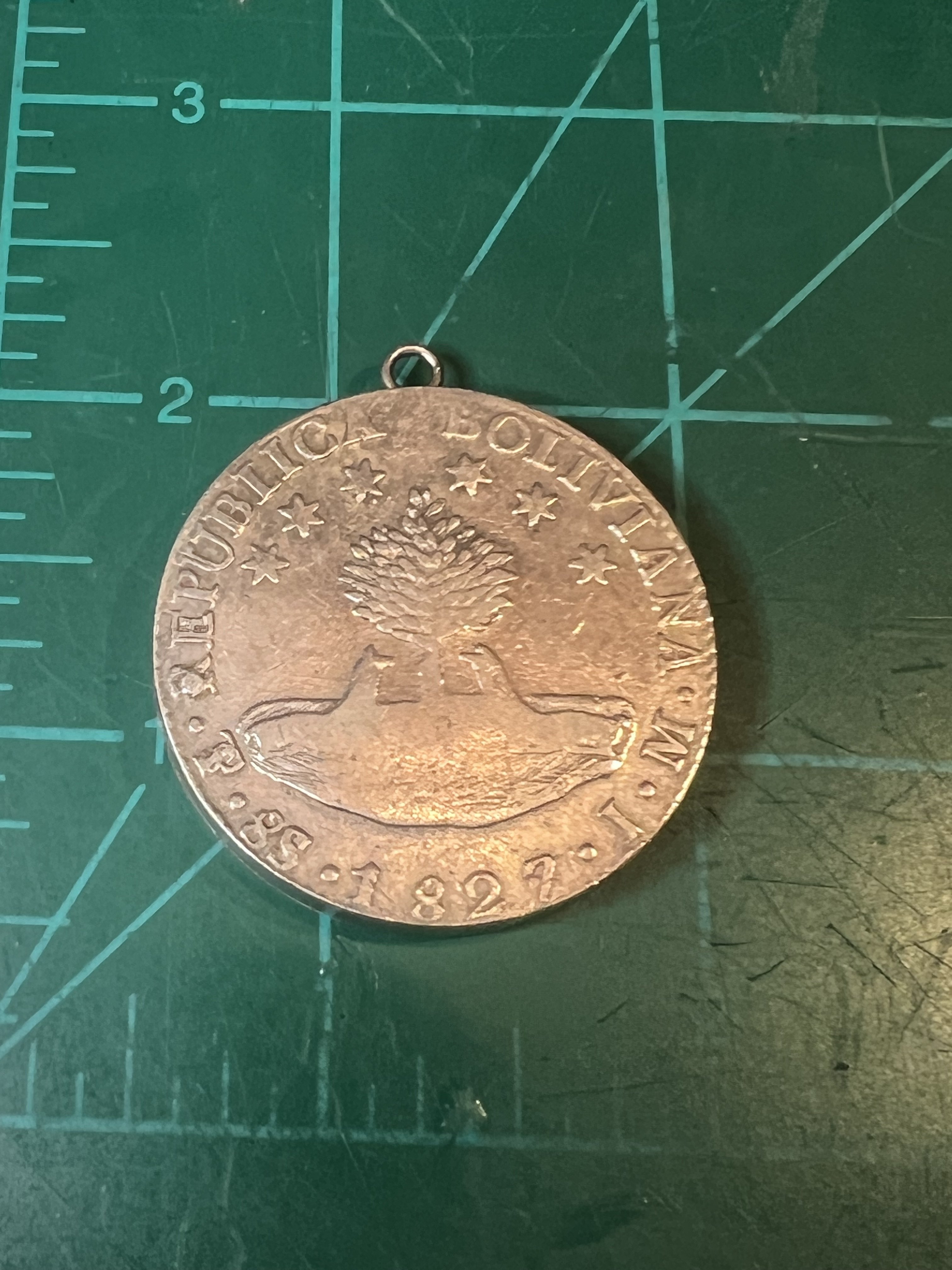
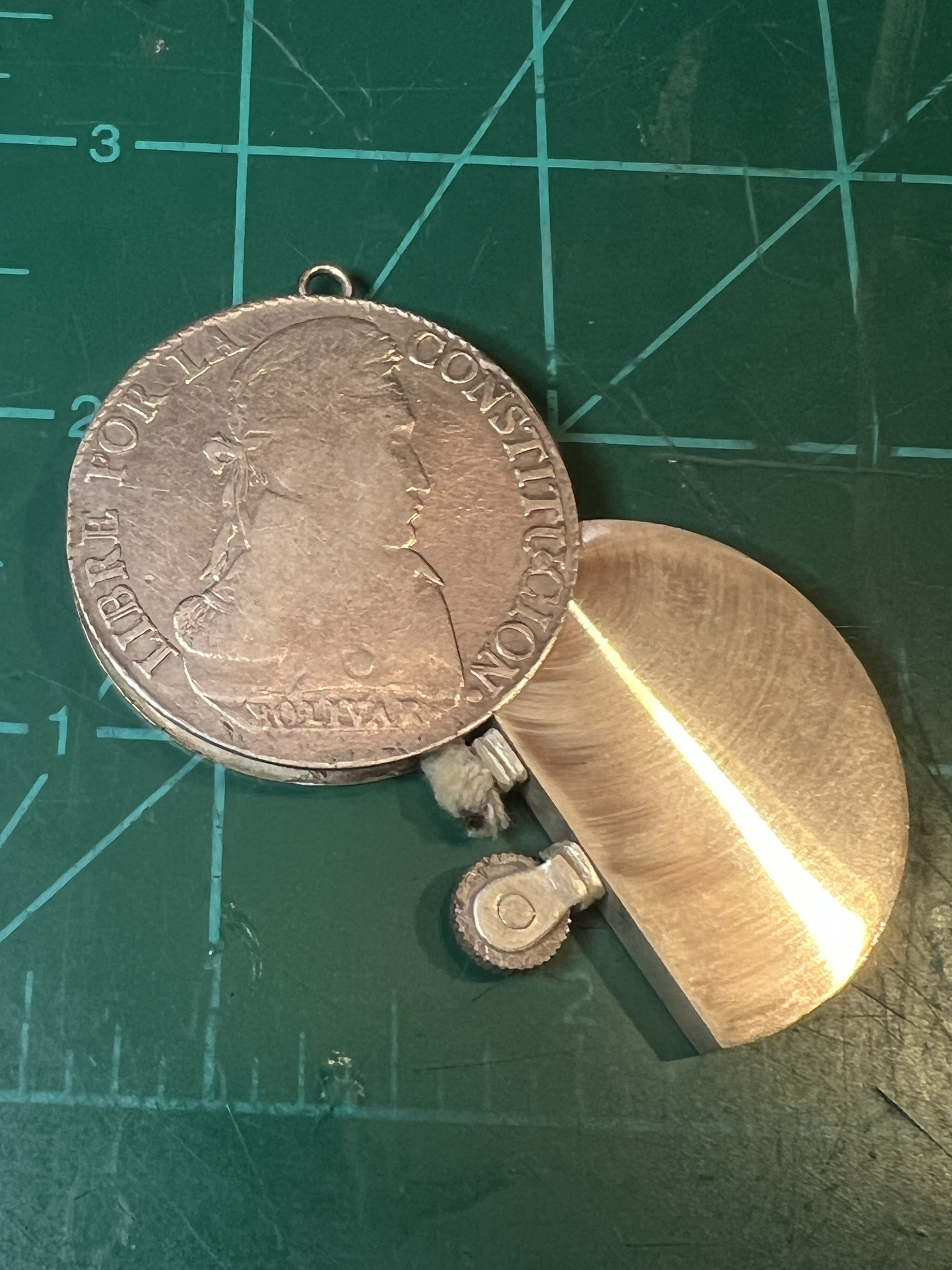
Five volumes of the draft catalogue of Julius Guttag are freely available on the Internet Archive website. I think in this form the catalogue of the collection is better than the scans of the printed edition.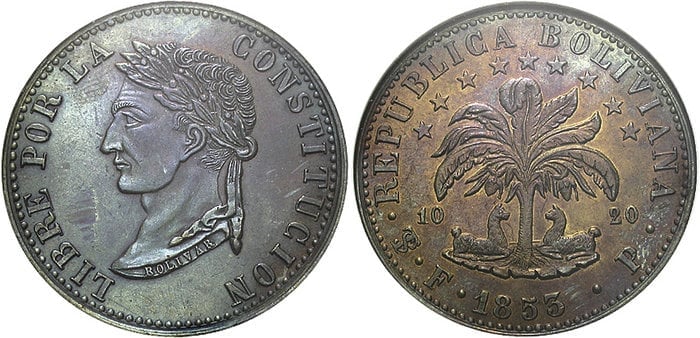
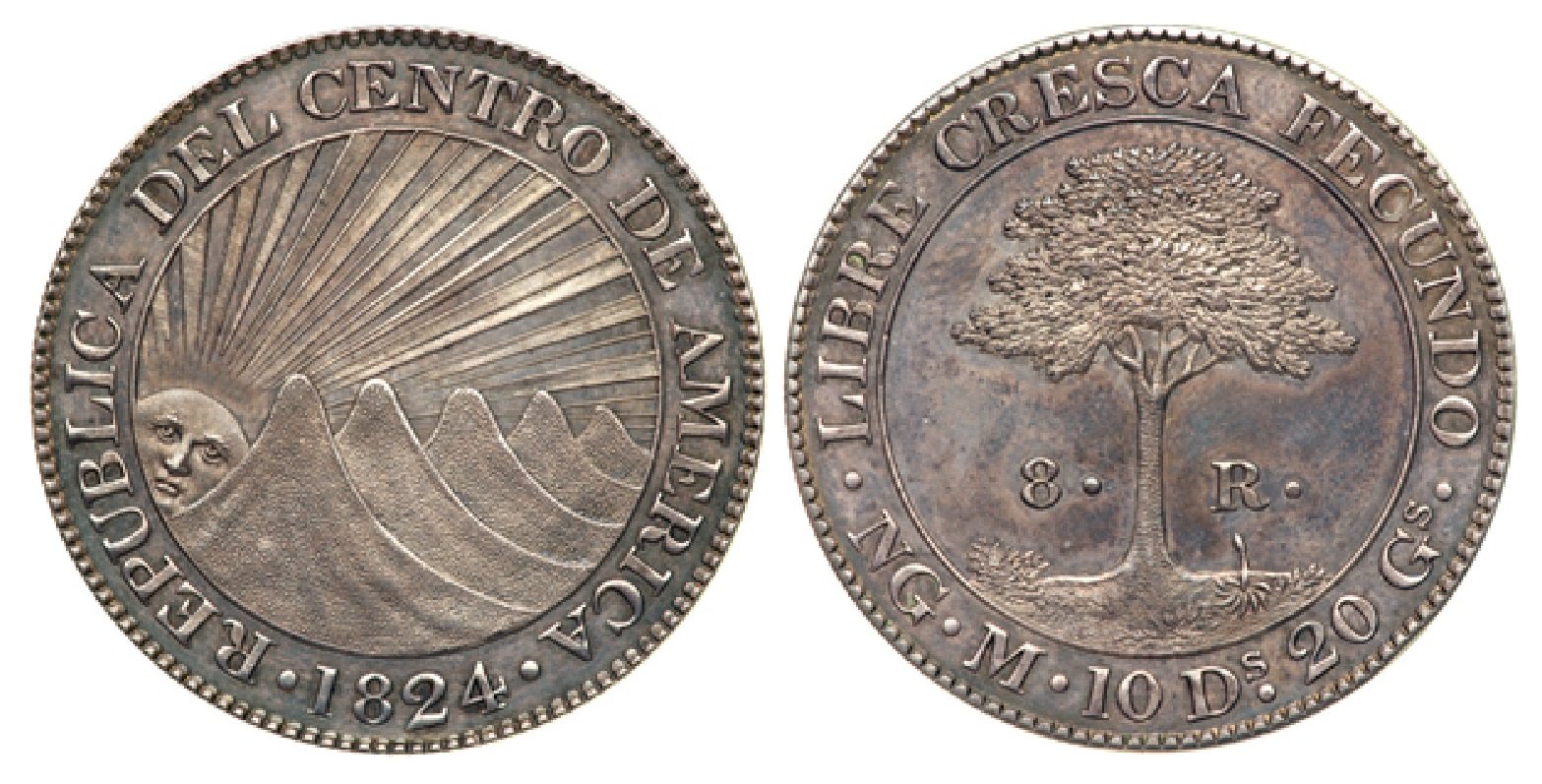
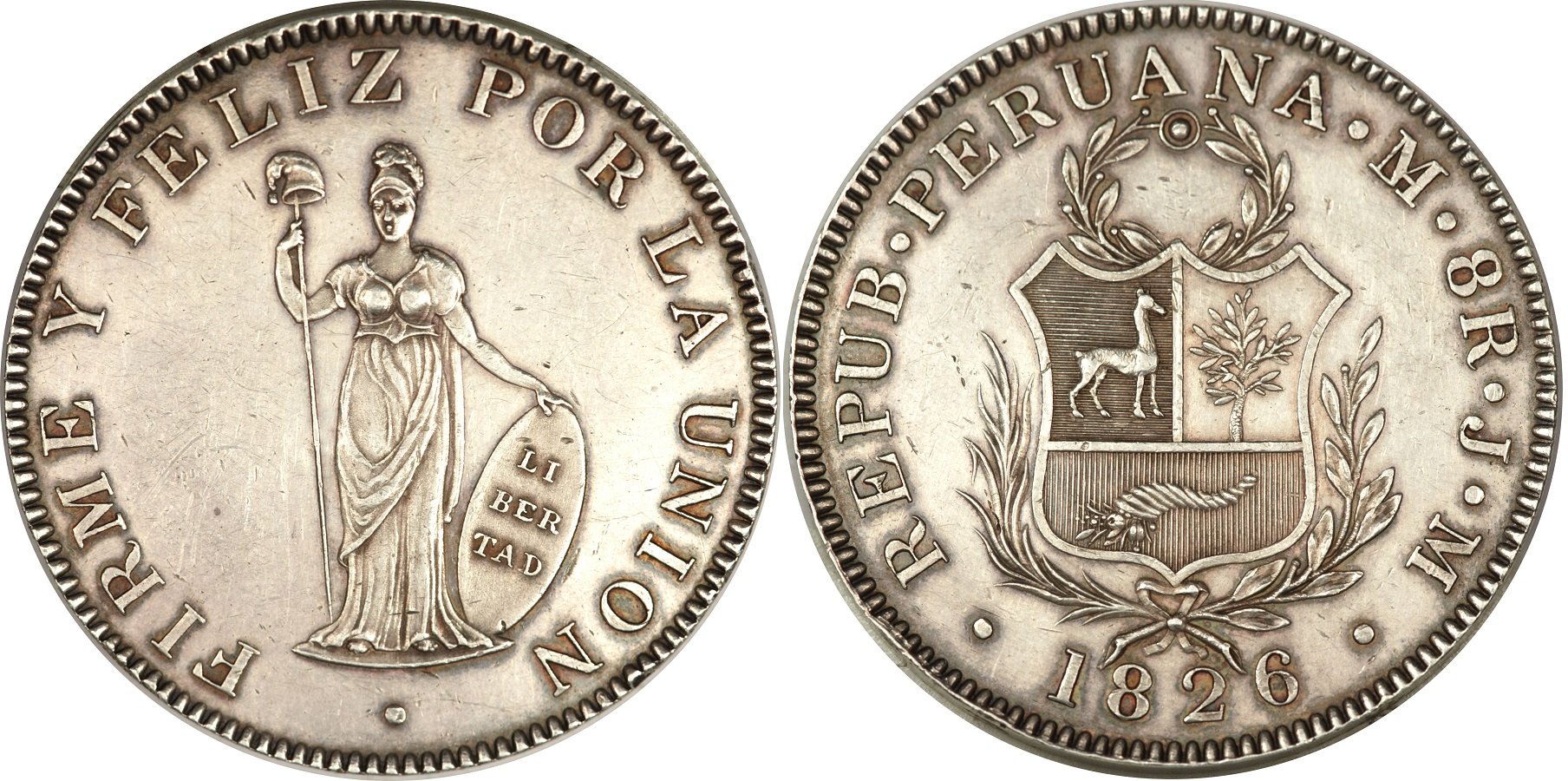
In general, this is a very interesting topic for research. There are several samples of coins of Peru, Bolivia, the Central American Republic, which are clearly made in Europe or the USA and are considered patterns.
Fac quod debes, fiat quod fiet
This coin has a standard weight of 27.07 grams for the 8 soles denomination.
The slab is mistakenly written that the weight is indicated above the llamas.
The silver standard 10 dineros 20 grains is indicated above the llamas
Fac quod debes, fiat quod fiet
I have not seen a minor proof coin in any of the major sales or shows. I actively look through old sales to explore new possible coins that aren’t listed in Krause. I have a fair amount of counterfeits, typically 4 soles, made from lots of different materials but their strikes/designs are typically cartoonish. The fact that both the 8S examples I’ve seen are 1853 FP, it makes me think that the “restrike” theory could be correct or that pattern/samples were struck to go along with the dies. To me the 1852-1856 portrait years have really sharp details (could they have been struck for Bolivia at a more advanced mint). Reminds me of the 1858 5F Ecuador coin which was produced in France.
These types of questions/discussions is what pulled me into Bolivia and other S. American Republic series coins. So many varieties compared to collecting US Roosevelt dimes for example. My focus now is unholed Bolivian proclamations.
I have a fair amount of counterfeits, typically 4 soles, made from lots of different materials but their strikes/designs are typically cartoonish.
Do you have any contemporary counterfeit 8 soles coins? If so, please show.
Fac quod debes, fiat quod fiet
The fact that both the 8S examples I’ve seen are 1853 FP, it makes me think that the “restrike” theory could be correct or that pattern/samples were struck to go along with the dies. To me the 1852-1856 portrait years have really sharp details (could they have been struck for Bolivia at a more advanced mint). Reminds me of the 1858 5F Ecuador coin which was produced in France.
The 1858 Ecuadorian 5 francs were struck at the Quito mint, not Paris.
The main reason I believe the coins shown are restrikes and not patterns is that they were struck "in collar" on a steam-powered press. The mints of the Latin American republics at the time used old, hand-operated presses. The real patterns (with signs of "in collar" striking) appeared when the old presses were planned to be replaced by steam presses. For example, the 1868 Clemente Torretti 1 boliviano pattern was made as a sample of the minting of the steam press that Torretti was selling to the Bolivian government. In 1853, as far as I know, the Bolivian government did not plan to replace the old hand presses with new steam presses.
Fac quod debes, fiat quod fiet